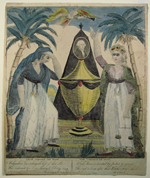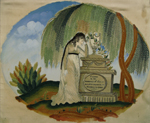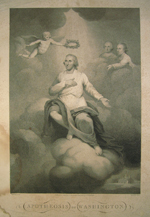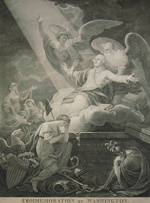|
Section I Selections from the C.W. McAlpin Collection
Section I Selections from the C. W. McAlpin CollectionSection VIIDeath of Washington On December 12, 1799, Washington rode out on horseback to inspect his farms, despite particularly hostile winter weather. By the following day he was suffering from a cold and throat infection. His symptoms quickly worsened, and during the succeeding night he awoke scarcely able to breathe or speak. He died in his bed on the evening of December 14, attended by his wife, his personal physician, Dr. Craik, and his personal secretary, Tobias Lear.
The suddenness of Washington’s death triggered an immediate demand for mourning pictures. The hasty execution of such images often resulted in rather unrefined prints that sought simply to bring together familiar allegorical components to memorialize the occasion (although the use of palm trees, instead of willows, is rare in American memorial prints). Here Washington is mourned by the allegorical figures of Columbia, on the left, and Justice, who directs the winged figure of Fame to “spread the sad tidings afar.” This was published together with a companion print depicting Washington on his deathbed attended by doctors Craik and Brown, and by his wife, Martha.
Many of the numerous engraved tributes to Washington after his death were translated into embroidery. This particular composition, illustrating a mourning female figure standing alongside a monument to the late president, beneath a weeping willow, is a common one, and therefore conceivably copied from a popular contemporary print. Most pictorial embroideries on silk of the Federal period were done by schoolgirls. It is likely that the image was painted on the fabric by a teacher, and subsequently worked over in threads by the student.
A notice of the publication of this print appeared in two New York newspapers on December 20, 1800. It described the composition as representing “a whole length portrait of Washington, rising gently in a graceful attitude on light clouds, from Mount Vernon, which appears underneath: On one side are the portraits of Warren and Montgomery, among clouds, descending in an inviting attitude toward our principal Hero: on the other side, a figure of Cupid, suspended in the air, attentively admiring Washington, and holding a wreath of Immortality over his head.” Richard Montgomery and Joseph Warren were both major generals in the Continental Army during the Revolution, slain in separate battles in 1775. A transparency by Rembrandt Peale, entitled Apotheosis of George Washington, is known to have existed in the early 1800s, and may have been the basis for the print.
This allegorical print, which bears a striking resemblance to depictions of the resurrection of Christ, portrays Washington lifted up out of his tomb by the bearded figure of Time, with the help of Immortality. The two mourners crouched below are Liberty and an American Indian; the figures of Faith, Hope, and Charity appear in the background. Two medals hang from the side of the tomb, representing two organizations of which Washington was a member: the Order of the Freemasons and the Society of Cincinnati. The rattlesnakes, fasces, eagle, and shield all symbolize various aspects of the new American republic. This work, also known as The Apotheosis of George Washington, was so popular that it went through four printings. It first appeared in February 1802, which would have marked Washington’s seventieth birthday.
|




